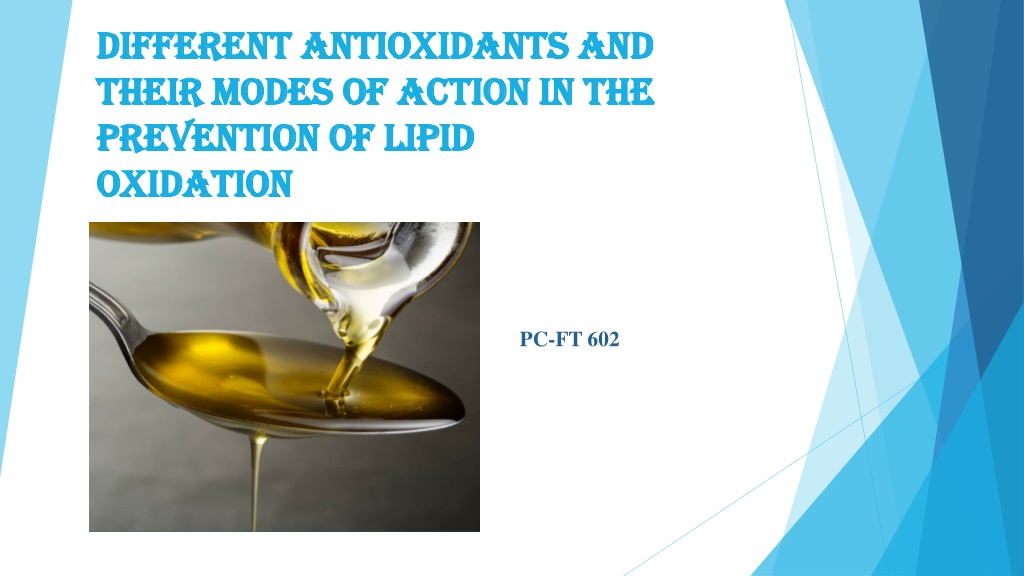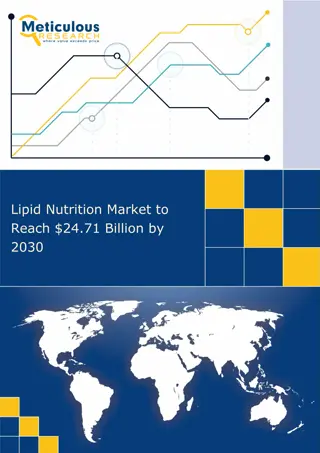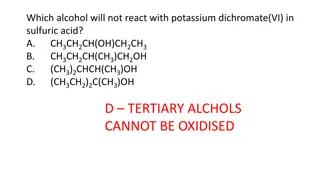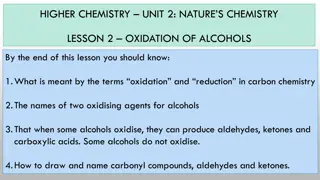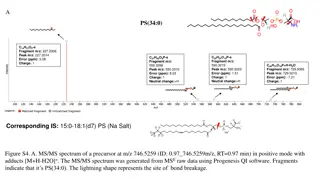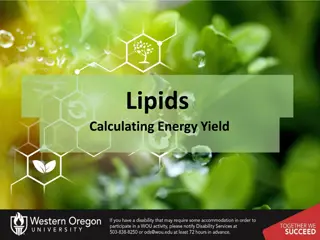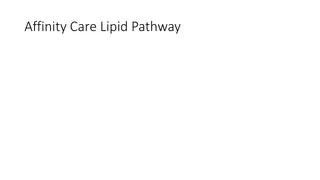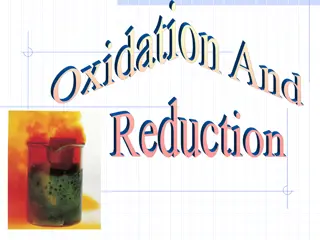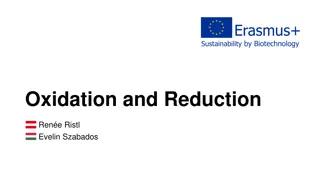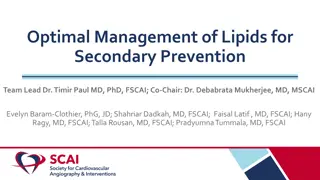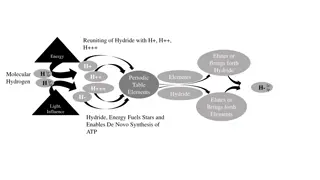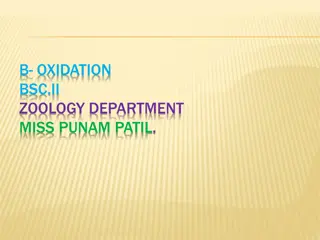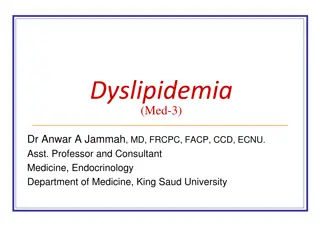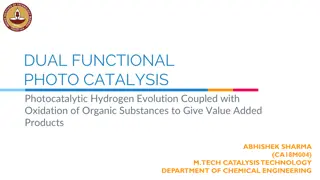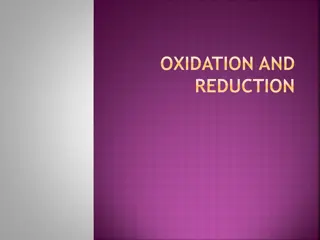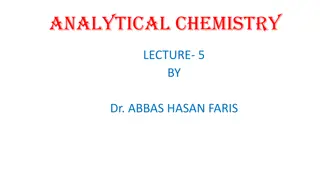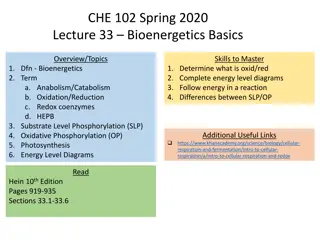Understanding Antioxidants and Their Role in Preventing Lipid Oxidation
Lipid oxidation is a crucial chemical process affecting the quality of fats and oils, leading to off-flavors and toxicity. Antioxidants play a vital role in delaying this oxidation process by scavenging free radicals through mechanisms like free radical scavenging. They help prolong the shelf life and wholesomeness of fats and oils by inhibiting the formation of harmful peroxides and hydroperoxides. Synthetic antioxidants are often added to edible oils to enhance their stability during storage and cooking.
Download Presentation

Please find below an Image/Link to download the presentation.
The content on the website is provided AS IS for your information and personal use only. It may not be sold, licensed, or shared on other websites without obtaining consent from the author. Download presentation by click this link. If you encounter any issues during the download, it is possible that the publisher has removed the file from their server.
E N D
Presentation Transcript
DIFFERENT ANTIOXIDANTS AND DIFFERENT ANTIOXIDANTS AND THEIR MODES OF ACTION IN THE THEIR MODES OF ACTION IN THE PREVENTION OF LIPID PREVENTION OF LIPID OXIDATION OXIDATION PC-FT 602
LIPID OXIDATION: Oxidation is the most important development in the fats and oils. The quality of the edible lipids largely depends on their resistance to this chemical change. An oxidized fat not only acquires off flavor, but also develops toxicity due to the formation of organic peroxides and hydroperoxides. Formation of singlet oxygen happens by light and response to photooxidation and the type II oxidation (photooxidation) of fatty acids by singlet oxygen produces trans-allylic hydroperoxides. Auto-oxidation
Antioxidants: An antioxidant is a substance added to fats and fat- containing substances to retard oxidation and thereby prolong their wholesomeness , palatability and increase their shelf life An antioxidant should not contribute an objectionable odour, flavour or colour to the fat or to the food in which it is present. The antioxidants are naturally present in foods, or can be added or formed during processing. Antioxidants for foods should be reasonable in cost, nontoxic, stable, effective at low concentration, have carry-through, and should not change flavor, color, and texture of the food matrix The artificial antioxidants should not have a harmful physiological effect and must be present in the food in compliance with the maximum limits given by the regulations. The addition of antioxidants helps delay lipid oxidation and improves the shelf-life of edible oils and fats, including frying oils. Synthetic antioxidants are often added to edible oils and fats to retard oxidation during storage and frying.
Mechanisms of Antioxidants in the Oxidation of Foods Free Radical Scavenging: Antioxidants scavenge free radicals of foods by donating hydrogen to them, and they produce relatively stable antioxidant radicals with low standard reduction potential. A free radical is an atom with one or more unpaired electrons in its outer orbit and these unpaired electrons cause free radicals to be highly reactive. Antioxidants which prevents or slows down the oxidation by donating hydrogen to them are called free radical scavengers. During the scission step of the oxidation step peroxyl radical and alkoxyl radical are mainly formed and these react with FRS and forms negatively charged FRS . The generated free radical always will want to react with unsaturated fatty acids but FRS will react faster than unsaturated fatty acids as the affinity is more and thus the fatty acids will not get the scope to react. Efficiency of FRS is dependent on reduction potential factor. Any component with reduction potential lower than the reduction potential of free radical will be capable of hydrogen donation to it. FRS chosen is at a lower energy state than the free radical , so it has a tendency to donate its hydrogen. Most phenolic compounds follow this method of action. The OH group donate the H atom and the FRS formed will be of low energy and the energy is delocalized.
Control of Prooxidants Pro-oxidants catalyzes oxidation process and if the concentration of pro oxidants is very high then the lipid will oxidize faster. Transition metals like iron , copper are pro-oxidants in food. When there is formation of hydro peroxide and there is no decomposition, pro-oxidants accelerates and initiates the process of hydro peroxide decomposition and thus accelerates the oxidation. Chelating agents along with antioxidants will be used here. The chelating agents used will take up the metal and thus will reduce oxidation. The amount of chelating agents used depends on pro-oxidants present and equivalent level or ratio of metal and chelator must be fixed. It solubilizes metal or form an addition compound by taking up a metal ion.
Control of Oxidation Intermediates Singlet Oxygen Quenching Photosensitizer Inactivation Inactivating Lipoxygenase enzyme
Different Antioxidants in the Prevention of Lipid Oxidation: Tocopherol (Vitamin E): Tocopherols are monophenolic compounds and derivatives of chromanol. They are very soluble in oil and thus are the most important antioxidants in edible fats and oils. Tocopherols are more frequently found in vegetable oils than animal fats, especially soybean, canola, sunflower, corn, and palm oils. Most vegetable oils contain tocopherols at concentrations higher than 500 ppm; beef tallow and lard contain less than 40 ppm. Palm oil contains tocopherols at 100 to 150 ppm, and also 620 to 650 ppm tocotrienols. The refining process, especially deodorization, reduces tocopherol contents in oils and thus added from outside. Methyl ester of alpha- tocopherol is mainly used as antioxidant. It mainly inhibit the lipid oxidation by scavenging free radical.
Polyphenols, Phenolic acids also act as antioxidants in many edible oils like olive oils and rice bran oil. It mainly inhibit the lipid oxidation by scavenging free radical. Ascorbic acid: It acts an oxygen scavenger and readily reacts with oxygen and thus prevents or slows down oxidation: Ascorbyl palmitate is used in fat-containing foods to decrease their oxidation. Superoxide dismutase, catalase, and glutathione peroxidase are known to decrease the oxidation of lipids. They mainly control the oxidation intermediates. The 2 main intermediates present are Superoxide anion and Hydroperoxides. In biological tissue whenever there is superoxide anion then it forms hydrogen peroxide. These enzymes help in the breakdown of peroxide to water and oxygen. Certain proteins like transferrin , lactoferrin act as antioxidants as they can bind pro-oxidants and thus can prevent oxidation. Application of enzymes and proteins as antioxidants is limited to unprocessed oil because oil processing denatures the enzymes and proteins.
Carotenoids Carotenoids are polyenoic terpenoids having conjugated trans double bonds. They include carotenes ( -carotene and lycopene), which are polyene hydrocarbons, and xanthophylls (lutein, zeaxanthin, capsanthin, canthaxanthin, astaxanthin, and violaxanthin) having oxygen in the form of hydroxy, oxo, or epoxy groups. Carotenoids are fat soluble and play an important role in the oxidation of fats and oils. Carotene is the major carotenoid in oils, and - carotene is the most studied. Palm oil is one of the richest sources of carotenoids. Crude palm oil and red palm olein contain 500 to 700 ppm of carotenoids. They act as a scavenger of singlet oxygen (excited state of oxygen which enhances the oxidative rancidity. Carotenoids mainly act by quenching the singlet oxygen : Physical and Chemical quenching Carotenids physically quench singlet oxygen by energy transfer from singlet oxygen to carotenoids. Carotenoids can also quench singlet oxygen by chemical reaction. Physical quenching is preferred as chemical quenching can lead to loss in colour of carotenoids.
Photo Sensitizer Inactivation: Foods contain sensitizers such as chlorophylls and riboflavin, which are activated by light. Photoactivated sensitizers transfer the energy to triplet atmospheric oxygen to form singlet oxygen, or transfer an electron to the triplet oxygen to form a superoxide anion radical, and these reactive oxygen species react with food components to produce free radicals. Carotenoids having fewer than 9 conjugated double bonds prefer the inactivation of photosensitizers instead of singlet oxygen quenching; singlet oxygen quenching is preferable by carotenoids with 9 or more conjugated double bonds. Energy of the photosensitizer is transferred to the singlet state of carotenoids to become a triplet state of carotenoids, which is changed to the singlet state by transferring the energy to the surrounding or emitting phosphorescence. The edge-to-edge distance for a direct quenching of triplet state of chlorophyll by carotenoids must be less than the van der Waals distance (0.36 nm), which enables some overlap between electron orbitals of these 2 pigments .
Synthetic Antioxidants: TBHQ , BHT , BHA are used as antioxidants in edible oil. TBHQ Tertiary Butyl Hydroquinone is used as antioxidant in vegetable oil BHT and BHA is used as an antioxidant in effectively in animal fats. They mainly acts by scavenging free radicals. 0.01% by volume TBHQ can be used for 9 months shelf life 0.02% by volume TBHQ can be used for 12 months shelf life.
THANK YOU
